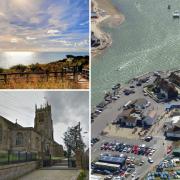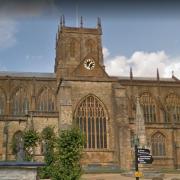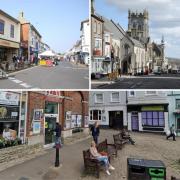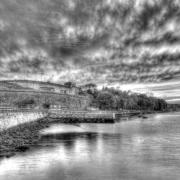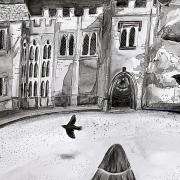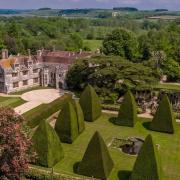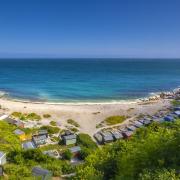On the 500th anniversary of Henry VIII's succession, Edward Griffiths finds Henry's castle standing guard over Dorset's 2012 Olympics sailing venue.
All over Dorset, there are Bronze Age and Iron Age hillforts, earthworks and 'castles' - all very popular with local people and visitors alike. But, apart from Sherborne's two castles, one at Lulworth and another at Corfe Castle, all of what visitors call 'real' castles were built along, or within, a cannonball's distance of the Dorset coast, where they stood firm-footed, ready to repel all invaders.
Plumb centre along the Jurassic Coast is the Isle of Portland, with Portland and Weymouth harbours sheltering behind its massive limestone bulk. Strategically important since time immemorial, Weymouth and Portland have been defended over the years by a succession of castles. Very little remains of Rufus Castle on Portland, and Weymouth has its Napoleonic Nothe Fort, but it isn't a castle. However, Weymouth does have two real castles, both built by Henry VIII to defend the important anchorage known as 'Portland Roads'. One of them, Sandsfoot Castle, was undermined by cliff erosion almost as soon as it was built, and it only survived until the 17th century. It is now a picturesque ruin but, facing it across Portland Harbour, secure in the guardianship of English Heritage and overlooked by elegant new apartments that are springing up on north Portland, is its companion, Portland Castle.
Henry VIII succeeded to the throne in 1509 and, together with Sandsfoot and Brownsea Island Castle, he built Portland Castle between 1539 and 1540. Portland Castle was continuously garrisoned for nearly 250 years and, with the development of the late-19th-century Royal Navy base, it returned to active service and remained in use until after the Second World War. Visitors who turn aside for a moment from the madding crowds dashing between Weymouth and Portland Bill will be rewarded with an exciting and memorable experience.
Why build the castle here?
Having defied the Pope by divorcing Catherine of Aragon and declaring himself Head of the Church of England, Henry VIII laid the whole country open to the threat of invasion by France and Spain, with the Pope's backing. Henry was forced to take nationally co-ordinated defensive measures, especially along the south coast, and Portland Castle is just one of Henry's nine major castles between Deal in Kent and Pendennis in Cornwall. Portland is one of the smallest and, built in little over 18 months, it only cost the equivalent of �5 million at today's prices.
Outside the castle
All of Portland Castle's gun batteries faced the sea, and its guns crossed lines of fire with Sandsfoot Castle less than two miles away across the bay. Viewed from the seashore, it is clear that the castle's seaward side is roughly semicircular. Facing inland, the two straight walls were protected at first by the original moat and, above the castle entrance, the slits for the drawbridge chains can still be seen. The gateway between the outer and inner courtyards displays a lead coat of arms of Charles II, inserted after the Civil War.
Portland's Tudor armoury
An inventory of 1547-48 shows that the castle positively bristled with all the latest equipment. Pride of place went to the brass demi-cannon with a bore of 6in (165mm) that could fire both lead and iron cannonballs. There were four 5in (140mm) bore breech-loading port-pieces, plus two brass demi-culverins and a Portuguese sling which were all 4in (115mm) bore. There were other miscellaneous slings, and three more iron breech-loading cannon. For closer combat there were eight handguns called hag bushes, 23 bows of yew, 77 sheaves of arrows, 12 billhooks and 12 Moorish pikes. All that should have ensured the garrison residents slept soundly in their hammocks!
Food
With its impressive fireplace for cooking, the kitchen was the warmest place in the whole castle, and the food prepared here for the garrison included local Portland mutton and fish. The staple diet would probably have been bread and cheese, and the men were given daily beer rations and, less regularly, wine. After all, the water would have been undrinkable. Excavations at other Henry VIII castles have produced bones of sheep, cattle, pigs, chickens and rabbits as well, so it wasn't always bread and cheese.
Rest and recuperation
The Tudor gunners actually slept with the guns in the semicircular gun deck, with timber partitions dividing the space against the back wall into four rooms. Although it's open to the skies now, this gun room was originally roofed over. Some of the men could also have slept in the room now called 'Gunners' Quarters'.
Battles and sieges
When the 'Catholic Invasion' failed to materialise, Portland Castle fell into a spiral of neglect and decay but, threatened with the Spanish Armada in 1588, the buildings were overhauled. When that threat evaporated as well, decay set in again and a 1623 survey produced a catalogue of repairs, including replacing the flat lead roof with a sloping tiled roof. During the Civil War, Royalist Portland and its castle was overcome by Parliamentary forces but, in 1643, a party of Royalists disguised as Parliamentarians recaptured the castle. Sieges of 1644 and 1646 failed, but the castle finally negotiated surrender with full 'honours' in 1646.
Portland Castle and Chelsea Flower Show
In 1999, English Heritage started the Contemporary Garden Scheme to introduce modern gardens to some of its historic sites where historical context would not be compromised. Chelsea gold medal-winning garden designer Christopher Bradley-Hole created the tranquil New Governor's Garden and a performance space based on a fine lawn, broken by bold swathes of ornamental Miscanthus grasses, and surrounded by a circle of Portland stone. Existing wind-sculptured sycamores have been enhanced by 12 new semi-mature Corsican pines and, beneath these, shrubs and grasses provide lots of movement.
Portland Castle Opening Times:
Daily from 1 April, the castle opens at 10am, closing at 5pm April-June, 6pm July and August, 5pm September and 4pm October.
There are special Easter Egg Hunt days from 9-12 April;



